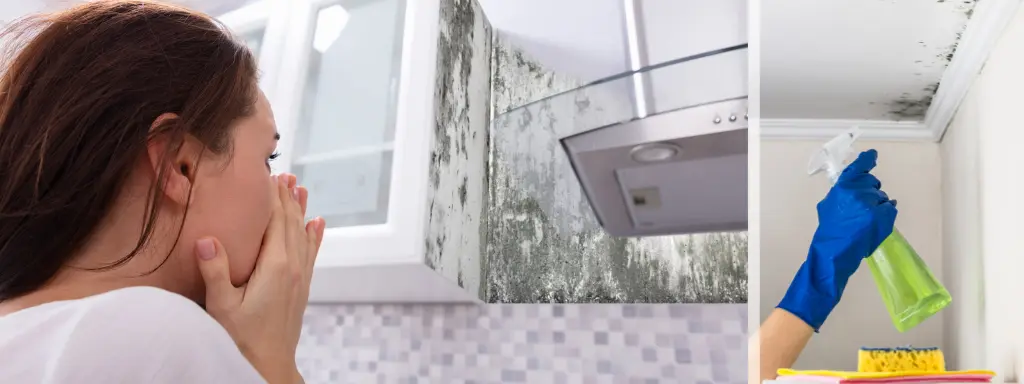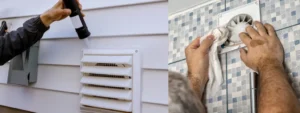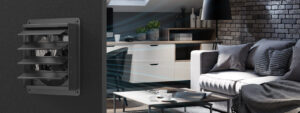Small airborne mould spores can create severe health problems and destroy home structures unless proper, swift action prevents their spread. The fact that mould spores reproduce in damp environments and stay suspended in the air for extended periods makes their removal troublesome after initial spread. Effective methods exist to eliminate mould spores while preventing their potential indoor invasion. This guide provides comprehensive information on air cleaning, techniques to prevent mould growth, and strategies to detect early warning signs.
Ways to Get Rid of Mould Spores in the Air

Eliminate Visible Mould
All mould spores develop from existing mould inside your home. Beginning mould remediation requires active removal of visible mould growth from wall surfaces, ceiling structures, and floorboards. Black, green, or white fuzzy patches indicate mould growth, and you should inspect these areas in bathrooms, basements, and kitchens.
- You can remove mould by applying either purchased mould removers or a solution of water and vinegar to contaminated surfaces.
- Keep gloves and a face mask on to prevent mould spores from entering your body.
- Professional assistance becomes necessary to deal with mould growth on porous surfaces such as drywall and insulation.
Install an Air Filter Box
Installing an Air Filter Box effectively captures mould spores and removes them from the air circulation. The system draws air through filters with high efficiency, capturing mould spores as they pass before they can spread throughout your home.
- Air filter boxes should be installed in the main living areas, basements, and bedrooms.
- Search for air filter models that contain HEPA filters that deliver peak efficiency.
- Regular replacement or cleaning of filters ensures the peak performance of your equipment.
Improve Ventilation with an Exhaust Ventilation Fan
Hot and moist air creates the perfect environment for mould to grow. Installing Exhaust Ventilation Fans in specific areas significantly decreases humidity levels while bringing in fresh air.
Pay special attention to humid spaces such as kitchens, bathrooms, laundry areas and basements. Exhaust fans should stay active for a period both during and after activities such as cooking or showering. Maintaining fans through regular cleaning operations helps improve their operational efficiency.
EXPERT TIP:
Exhaust fan vents should be directed outside the house, rather than pointing toward the attic or crawlspace, as this prevents the removal of all moisture.
Use Dehumidifiers
Dehumidifiers extract moisture from the air, which makes mould spores uncomfortable. Low indoor humidity, below 50%, prevents mould spores from finding suitable conditions to grow.
- Place dehumidifiers in damp areas.
- Regular water tank purification and cleaning procedures must be performed.
- A hygrometer should be used to check indoor humidity levels.
Clean Air Ducts and Replace Filters
Your home receives mould spores from air ducts, acting as mould collectors. A prolonged period without HVAC system cleaning may be contributing to your current situation. Regular professional duct cleaning should be scheduled every three to five years to maintain clean air quality. Change your HVAC filters according to usage, but do so at least every one to three months. Upgrading your filter system with spore-capturing models is an additional method to achieve maximum protection against mould growth.
How to Prevent Mould Growth at Home
Fix Leaks Quickly
Mould spores quickly multiply in spaces with water leaks. You need to repair any leaks you detect under sinks, on roofs, or within your walls as soon as possible. Always check your plumbing and roofing systems as part of your regular inspection routine for potential trouble areas. Various vulnerable locations can be protected from leaks by applying waterproof sealants.
Control Indoor Humidity
Mould grows entirely in humid indoor environments. Regular small habits, combined with the use of dehumidifiers and ventilation systems, prove crucial for preventing mould. When preparing food or taking baths, use exhaust fans instead of turning them off. Dry clothes outside your house, and cover your pots during boiling times to minimise indoor moisture.
Keep Your Home Clean and Dry
Mould spores require moist environments where dust and dirt serve as traps to facilitate their growth. Regular surface cleaning, including wiping and vacuuming with HEPA-filtered vacuum cleaners, helps keep your home free from mould. Wet towels, rugs, and clothes must be placed in specific locations, as any area left unattended can quickly become mould-infested.
Use Mould-Resistant Products
When performing home repairs, select materials that are mould-resistant. Drywall, insulation, and mould-resistant paint are effective products that prevent mould growth.
Signs You Might Have Mould Spores in Your Home
The following indications show that mould spores exist in your indoor air:
- Persistent musty smell.
- You experience regular coughing attacks, sneezing, and eye discomfort while staying inside your home.
- Your symptoms of headaches and dizziness tend to disappear after you leave your home.
- You will see mould appear on walls, ceilings, and furniture surfaces.
- Condensation on windows or pipes.
Are Mould Spores Dangerous?
The presence of mould poses a danger to anyone who suffers from asthma and allergies, as well as those with weakened immune systems. When people inhale mould spores, they can develop allergic reactions and face respiratory problems; sometimes, the spores may lead to severe infections. Your health remains unaffected at first, but prolonged contact with mould poses various health risks and degrades indoor air quality. Following proper spore removal procedures defends your health and your household environment.
FAQs
What Are Mould Spores?
Mould spores are the microscopic structures in the fungi produced by the larger colonies of moulds. It’s native to natural surroundings, but becomes problematic if it finds its way inside a home or office, where dampness facilitates its growth.
How Do Mould Spores Get into the House?
Spores can easily enter through any gaps, windows, doors, or vents. They also come in through clothing, shoes, or pets. They enter the storeroom and move aimlessly around until they locate a suitable area with some moisture for their growth.
Is it possible to eliminate all mould spores from the air?
It is almost impossible to eliminate the spores, as they are naturally present in the environment. However, they can be significantly minimised through filtration, ventilation, and the management of moisture accumulation.
How long does it take for mould spores to remain airborne?
These mould spores float in the air for quite some time, especially in areas experiencing mould regrowth or poor airflow. Regular cleaning and the use of air filters can minimise the appearance of these particles.
Final Tips
- You need to inspect areas of the house that may be susceptible to dampness, such as the basement and the spaces behind sinks.
- Regular cleaning and dehumidification of windows and vents are required.
- Consider features such as an air filter box to enhance air quality.
- Select a powerful exhaust ventilation fan to remove humid air from your home’s rooms.
- Do not delay when you find mould or get a whiff of it!
Conclusion
Mould spores in the air are relatively easy to deal with if you learn the proper approach, the appropriate tools, and the right approach to moisture. Making your home safe, healthy, and free from mould can be simple if you follow the abovementioned steps.





